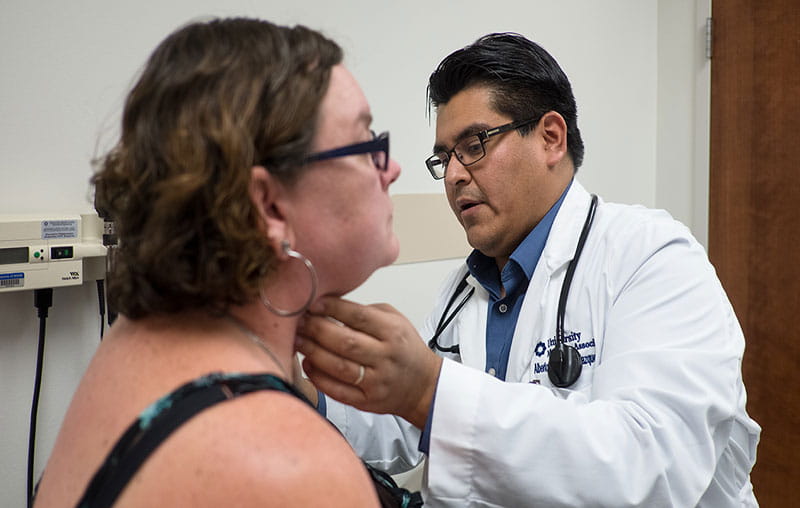Nearly 9% of the world’s adults have diabetes. Though there are different forms of diabetes, they all have the same common element: the body’s inability to properly process sugar. This can be due to the pancreas failing to produce enough insulin or your body’s cells not responding properly to the insulin produced.
“One of the greatest barriers to keeping diabetes under control is monitoring blood glucose, or the level of sugar present in the blood,” says Dr. Aruna Venkatesh, an endocrinologist with University Health and diabetes researcher at the Texas Diabetes Institute. In addition to regularly monitoring diet and activity levels, testing blood glucose levels is an important, routine part of managing this common disease.
Unfortunately, the process of checking the body’s sugar levels is somewhat unpleasant. Every day, patients prick their finger with a lancet (needle) device and squeeze a drop of blood onto a monitoring strip to analyze and reports the level of sugar present in the blood.
Thanks to medical researchers who are always looking for ways to make managing diabetes easier for patients, there are now more options available to diabetic patients in addition to the traditional finger stick.
A Condition with Ancient Origins
Diabetes has been described by various cultures stretching back thousands of years, making it one of the oldest known diseases in recorded history. Measuring blood sugar is a more recent development in managing diabetes. Over the last 100 years, the methods by which we measure the level of sugar has evolved greatly. Early on, ketones were tested in the urine to determine blood sugar levels. Ketones are chemicals produced by your liver when your body can’t turn sugar into energy. Scientists later developed a process to actually test for sugar present in a sample of urine.
Now, testing the level of sugar present directly from a sample blood is commonplace for determining the extent of a patient’s diabetes.
A New Way to Monitor Blood Sugar
If you’re sick and tired of pricking your finger, you will be pleased to know that there is now a more pleasant method of regularly checking blood sugar. A continuous glucose monitor (CGM) is a small sensor inserted under the skin on the arm, abdomen or upper buttocks that tests blood sugar levels by regular intervals (usually every 5 minutes).
Depending on the type of device, the CGM can log the readings or even transmit real-time data. Some models give feedback in the form of a beep if your blood sugars are too high or too low. Some devices can store data to review later with your doctor, or you can wave a smartphone over the sensor to get an instant reading of your blood sugar levels.
While not brand-new technology (the first CGM device was approved for use in 1999), recent advancements and the increase in diabetes diagnoses in the United States have led to the devices becoming easier to use, cheaper and more widely available.
There are many benefits to using a CGM, according to Venkatesh. “Studies have shown patients who use a CGM have an improved quality of life because they better understand the consequences of their actions,” says Venkatesh.
Research is also clear in the positive outcomes for patients using CGM devices. Numerous studies have shown patients using CGM devices:
- May see a decrease in their A1C (as much as 0.5% for type 1 diabetes)
- Are more likely to make smart choices in their diet and activity levels
- Show up to a 38% reduction in hypoglycemia
- Benefit from improved neonatal outcomes including reduced instances of large birth weight and fewer NICU admissions
CGM devices can help patients understand trends in their diabetes, including showing you when your blood sugar increases as a result of an unhealthy meal or lack of activity. Recognizing these trends can help someone with diabetes manage their disease. “Knowledge is power,” says Venkatesh. “Recognizing how much time you spend in the healthy range of blood glucose levels can help you better manage your habits. The extra data points you get with CGM paint a more complete picture.”
Caution with CGM Devices
The benefits far outweigh the drawbacks for continuous glucose monitoring, according to Venkatesh. But the devices do have their limitation.
“Because CGM measures glucose levels in your interstitial fluid instead of directly from your blood, there is a 5-10 minute delay in any reading from the device,” says Venkatesh. So, while the CGM can give you a better idea of your levels throughout the day, measuring by a finger stick is still the most accurate form of checking your blood sugar level.
There are also barriers to getting access to the devices, but Dr. Venkatesh says those barriers are slowly going away.
“Right now, CGM is only available by prescription, but most private insurance and now even Medicare and Medicaid cover the monthly cost,” says Venkatesh.
Even patients paying out-of-pocket for their CGM devices are better off now than they used to be. The cost was about $150 a month, but more recently sensors cost between $40-$60 each and patients will need two each month. CGM readers, standalone devices which can cost $75 or more, are being increasingly replaced by smartphones.
Everybody Should Wear One
Venkatesh is clear in her endorsement of CGM as a tool to help fight diabetes. “Everybody who is prediabetic or diabetic should wear one,” she says. “Do it before your symptoms are out of control so you can be mindful of what is happening in your body.”
There are currently criteria for who can be prescribed a CGM device. Venkatesh says in order to get a prescription you must:
- Take three or more injections of insulin daily
- Show that you check your blood sugar more than 4 times per day
- Demonstrate that you actually use the information to adjust your insulin
“The Endocrine Society and American Medical Association both recommend CGM use for type 1 and type 2 patients where appropriate,” says Venkatesh. “It’s a wonderful tool in our fight against diabetes.”
With diabetes at epidemic levels in the United States, Venkatesh believes devices that help us better understand the disease and how to manage it are critical resources. “Frankly, I think everyone should wear one,” she says with a laugh.
Diabetes Care at University Health
Endocrinologists at the world-renowned Texas Diabetes Institute are always advancing diabetes care through research and best-in-class patient care. Call 210-358-7000 to learn more or make an appointment.





